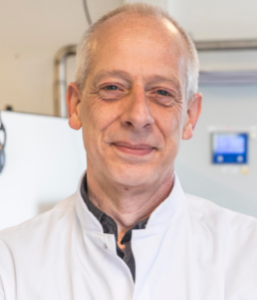VBHC requires medical leadership
Curfs knows for sure: Value-Based Healthcare (VBHC) will change and improve care. ‘We need to do things differently. Healthcare is getting too expensive. Not just in the Netherlands but worldwide. People are getting older, technological possibilities increase and medications get more expensive. We need to find a solution, and that is VBHC. I’m so enthusiastic about VBHC because it appeals to the intrinsic motivation of the healthcare professional who wants to deliver the best possible care. So the prime goal is how to improve care, not how to organize processes more efficiently. In our hospital (Isala), a lot of attention is being paid to the Lean methodology. This is good as you can standardize care pathways. But delivering care to people, patients, is quite different from the production process of, let’s say, a Toyota. That is my side note on Lean. VBHC is different, and that’s why it’s going to work. I’m sure.’
“Value-Based Healthcare will change and improve care.”
Anonymous registration
Isala really got to know VBHC for the first-time last year. There were training days for managers and employees, and department leaders followed a master class. Two VBHC projects were started; one for patients with colon cancer and one for women, couples, with fertility problems. Curfs is the enthusiastic chairman of the VBHC team at the Fertility Centre. ‘It’s not something you do on the side. It takes medical leadership to get everyone involved. We wanted to participate because we already have been improving our care pathways for several years. We continuously seek for opportunities to do better for our patients. And instead of determining what we think is best for them, we involve them in this. For example, we have been organizing Grand Cafés in an informal setting for a number of years, outside the hospital. Patients (couples) engage in conversation with members of our team. We learn so much. An example. Patients must register at the hospital at a post, not at a desk. We found this impersonal and we had this plan to renovate our building which we share with a few other departments. We pictured a desk at the entrance and a friendly face behind it. But one of the patients told us that she actually liked the anonymous registration. Just enter your ID and move on.’
“It’s not something tou do on the side. it takes medical leadership to get everyone involved.”
Own building
Located in a building right next to the hospital helps the Fertility Centre enormously with VBHC. Curfs: ‘We hold clinic appointments here, can do some diagnostic procedures and we also now have our own pharmacy. Patients no longer have to go to the pharmacy in the hospital. So to speak, an IPU is in place with the focus on patients with unfulfilled child wish. Of course, not all professionals can be in the IPU, a hospital within a hospital is not realistic.’
The right tool
After six multidisciplinary meetings, the major care pathways were completely reviewed and the outcomes measures, both medical and patients reported, were determined. All in close collaboration with patients. Questionnaires to measure the quality of life were selected. But unlike for the medical outcome measures, the Fertility Centre does not yet have a tool for presenting the questionnaires to the patients and processing the results digitally. Curfs thinks this is unfortunate. ‘This is extremely valuable. We have experienced this with measuring our medical outcomes. Fertility treatments usually are offered several times in succession before we proceed to the next, more invasive step in the fertility treatment. As it turned out, we must offer fewer of these treatments than the guidelines suggested since the plateau in cumulative live birth rate was reached much earlier, making more cycles obsolete. We really had no idea that this was the case since up until now, outcomes were only measured on a per cycle basis. In the consulting room, this information leads to shared decision making between physician and patient (couple). The questionnaires that measure our patients’ quality of life will also improve healthcare. Patients at risk can be identified, not only at the first consultation but also during the many months and even years that patients visit our center. And lastly, we can learn from the information we collect and then share with other fertility centres.’
“We can learn from the information we collect and then share with other fertility centres”
Best possible care
VBHC is not just for care providers and hospitals. Curfs: ‘Good agreements with health insurers are a requirement. The financing of healthcare will change in the future. I can imagine that we will soon offer the total fertility program for a fixed price, from first referral to our center until discharge from our center. This bundled payment is all inclusive, no matter how many examinations and treatments we execute. We are transparent in what we do and how we do it, to what result. Of course, we provide the best possible care. Because that’s what we care about.’


